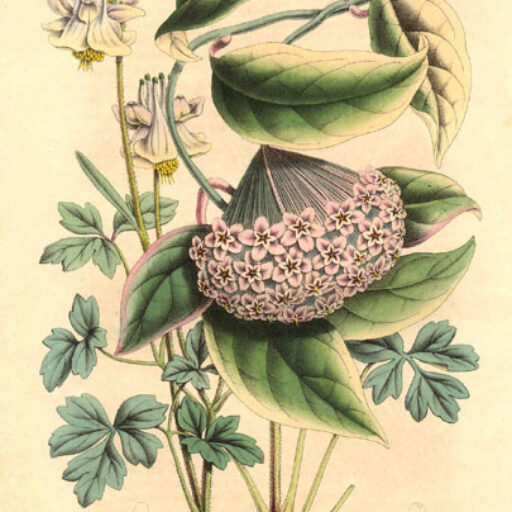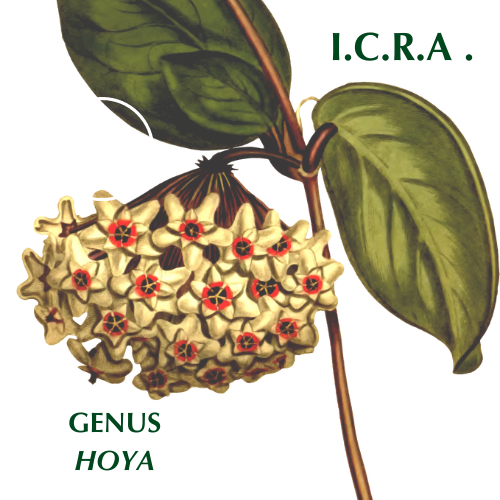
Welcome to the home of the International Cultivar Registration Authority for the genus Hoya, and an online learning resource dedicated to the genus in cultivation.
A cultivar is a specific status under the International Code of Nomenclature for Cultivated Plants. It represents a plant which has been selected for one or more features which then remain distinct, consistent, and uniform after it has been propagated (see Brickell et.al. 2.3 for the full definition). And then, in order to be considered a cultivar, it must be published (Brickell et.al Note 9.1).
The Cultivar Checklist is here so that you can see the nomenclatural status of individual cultivar names in the genus, and submit the names of cultivars for registration. Hoya has been without an ICRA, so I appreciate your patience while this has been underway.
I am now finally completed with the initial research phase of going through decades of old literature. The Cultivar Checklist is rapidly growing now, and it is an exciting time!
It has been so important to take great care during this process; to acknowledge the extensive history in horticulture and vast possibilities, while making effective decisions so that we can refer to these plants which we love and grow.
New Groups are forthcoming here, and will be established in Stemma Journal. This will come alongside an outline of plans for the future and steps taken so far. This should come out around same time as the Cultivar List comes up to date with the bulk of the fully established Hoyas.
Register Hoyas!
Do you know of a novel cultivar? Are you not quite sure? Are you a breeder or raiser? Do you have a sport, hybrid, open pollination, or know of a longtime name that you think should be registered and it might qualify? Perhaps you have a suggestion for a Group? Submit a registration form or send me a message, and let’s find out.
If you have a brand new mutation or seedling, keep on growing it and stabilizing it. It may qualify to be a cultivar, but it’s important to have enough plant to introduce to a market, and to really understand your potential cultivar and have time to compare it against others in the trade. There will be much more on this soon. In the meantime, all applications are welcome and this is to answer many questions at once about novel introductions.
About the ICRA & Registrar
I am Rachel Colette Conroy, an independent researcher in Michigan, USA. I keep a large collection of cultivars here to study, share, and preserve, as well as a library of publications, research material, and herbaria. All are available to the public by appointment, and will be added to this the site or stemmajournal.org digitally where copyright permits.
While the ICRA is an individual structure, I am hardly alone. There is a collective of researchers and organizations collaborating who have been helping to make this happen. It especially would not be possible without Mark Randal, Asst.Registrar, and Stemma Journal.
Wherever you are in the wider world, welcome to this online world of Hoya cultivars. If you are here to register a cultivar and learn how to establish its name so that it has nomenclatural priority, you are in the right place. This is also the single place to check the correct name for a cultivar within the genus, and its status.
Key to Cultivar Status within the Cultivar Checklist:
Accepted: The name is accepted by as the correct name representing a unique cultivar. It may still need to be formally established in the next print registry.
Synonym: An established name that is not the accepted or adopted name. (ICNCP 11.2-11.3)
Invalid:A name contrary to the rules of the code, or which was never established, and/or does not represent a unique cultivar.
Established: A name attached to a unique cultivar, which has been published meeting all conditions of Article 27.
Established Undetermined:A name which has been established meeting all conditions of Article 27, but which may or may not be attached to a still extant cultivar, or to one which is unique.
There is only one correct established name for any cultivar. Many cultigens (cultivated plants which may or may not have cultivar status) are not necessarily established.
Using the Checklist:
You can sort by the categories above, by alphabetical order, or even search by tags. Simply select which category you would like the list to be ordered by.
A brand new site at the same domain will be setup to make everything more usable as time goes on. If you have any problems ordering the list or finding a particular cultivar, please reach out.
Goals of the ICRA:
- Determine the correct name for every Hoya in cultivation which meets the definition of a cultivar.
- Register new unique cultivars with names that will not duplicate any others and meet the guidelines of the code.
- Be sure that new registrations become properly established so that their names have nomenclatural standing
- Create a comprehensive and fully searchable online Cultivar List which includes newly registered cultivars, and previously established names with their status which anyone can access in order to see which is the correct name to use.
- Place print volumes of the Cultivar List into research institutions and circulate with interested individuals and organizations.
- Alongside each cultivar, include also: trade designations, trademarks, synonyms, and all known history of the cultivar. hoyacultivars.org and the Cultivar List will also include cultigens. As many known names on the market, invalid names, and eventually interesting history about the genus Hoya and horticulture.
- Follow all guidelines of the International Code of Nomenclature for Cultivated Plants.
- Develop hoyacultivars.org into a very full cultivar resource with articles specific to cultivars, guides related to how to name, and other tools for growers and originators
- Improve our network in all parts of the world where Hoyas are being selected in cultivation
Registration with the ICRA does not confer any legal protections for a cultivar and its name, nor does establishment. Legal protections are separate from establishing a cultivar by publishing a correct cultivar name in print along with a description or diagnosis, and can be pursued via patent protections or PVR in UPOV member countries if this is beneficial to the breeder and the cultivar. The two are never mutually exclusive. If the pending patent, PVR, or PBR does not need to be kept private due to being a part of a multistage propietary development process (for example), a copy of the application should be sent to the ICRA so that the name can be Accepted and added to the registry.

